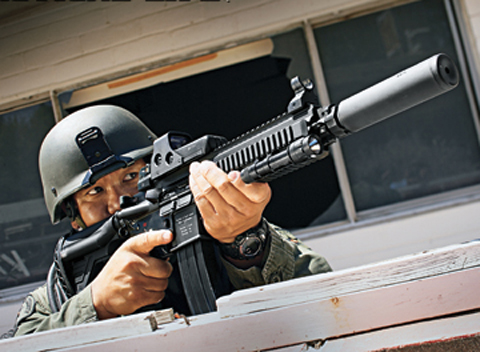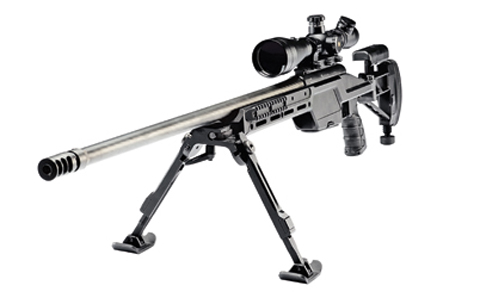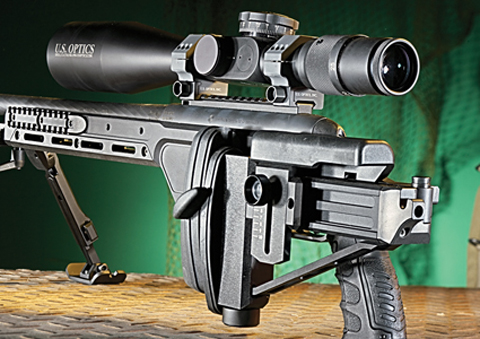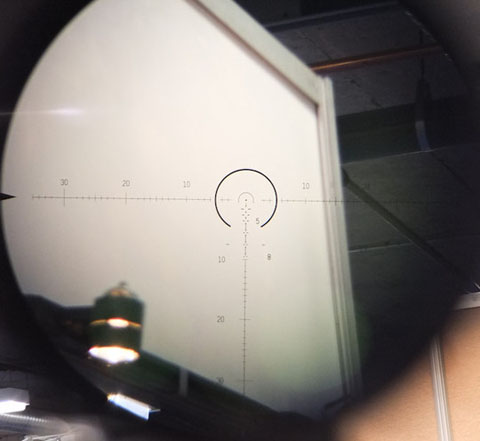2012年02月18日
Silencer Science
私たちのブログを訪問していただきありがとうございます。あなたがお持ちの場合DIYの要求は私達に電子メールを送信してください。
GemTech’s Dr. Phil schools us on everything we’ll ever need to know about high-quality suppressor technology.

SureFire’s Barry Dueck testfires a First Gen FA556 suppressor which has been upgraded with a better locking mechanism.
Ignorance and stupidity are not the same. Ignorance is a lack of information whereas stupidity is the inability to comprehend the information available. In my case, however, both apply. Worse yet, I think I’m fairly smart which means I don’t know what I don’t know. I’m about to discover just how dumb I am on the subject of suppressors because I’m here at Long Mountain Outfitters in Nevada to take a suppressor class from the acknowledged dean of silence, Dr. Phil Dater.

Suppressors are not without their drawbacks. Adding a pound or two to the muzzle slows target-to-target acquisition and makes the weapon longer, and thus more cumbersome in CQB.

Dr. Dater is a retired medical doctor, a radiologist, who turned a lifelong hobby of researching sound suppressors into a profession more than 30 years ago. He is one of the owners of a leading suppressor manufacturer, Gemtech, and also consults through his Antares Technologies side-business. Phil, as he prefers to be called, is about to educate me with a graduate-level understanding of cans.
What, then, is the sound of a gunshot? I now know it’s a wave of over-pressure, meaning a pressure wave that’s greater than the local pressure of the medium—air. Okay, but how is that sound generated? The answer to this question, it turns out, cuts to the chase of suppressors.
By Cameron Hopkins, Images by Ichiro Nagata
BLOG ARCHIVES

2012年02月18日
Steyr SSG08 .338LM
私たちのブログを訪問していただきありがとうございます。あなたがお持ちの場合DIYの要求は私達に電子メールを送信してください。

Our resident sniper trainer wrings out the newest bolt-action sureshot that’s packed with shooter-friendly features.

With the US Optics SN-3 5-25X T-PAL scope and the standard 20MOA base, the only limitation is the .338LM ballistics. The 27.17-inch heavy forged barrel will keep the accuracy at sub-MOA and extract all the speed available on the big Lapua case—to a mile away and beyond!
The SSG08 is, in many experts’ opinion, one of the best .308 sniper rifles available. It has blown away its competitors in the Government trials where it has participated, against the best sniper rifles on the market. Considering it has been available a little over a year, that is a remarkable feat. If all goes well, politically, I have been told that there will be some very important contracts soon. Sadly, Steyr rifles have a hard time winning the hearts and minds of the U.S. operators and agencies, for some complex reasons—the most important a defamatory campaign by a British newspaper some years ago.

The folding stock system has proven rugged on my .308 SSG08. After 1,500+ rounds, it shows absolutely no play. The new 338LM rifle has the same design.
If you already are familiar with the SSG08, from shooting it or otherwise, take note: There are some new and important features in the new .338LM SSG08. New engineers are joining the team at Steyr, adding fresh blood to the already extensive experience of the design teams, and new ideas are coming on line.

The SBS allows safe manipulation of the loaded gun and provides the action and barrel assembly with a bushing that will make it survive most overpressures, while keeping the shooter safe.
Steyr is the only manufacturer offering sniper rifles with cold-hammer-forged barrels. Cold hammer forging is a process in which the barrel is forged over a mandrel that has the lands and grooves imprinted into it. This forms the barrel with incredible precision and increased hardness, compared to traditional rifling methods. SSG barrels are known for their superb accuracy, ease of cleaning and long life, due to this ultra fine interior barrel finish. As a side benefit, the process leaves a unique spiral mark all over the length of the barrel, a Steyr-Mannlicher trademark. Although these SSG08 barrels were incredibly accurate, they had a drawback: In my opinion they were too short.
By Eduardo Abril De Fontcuberta, Images by Steve Woods
BLOG ARCHIVES


Our resident sniper trainer wrings out the newest bolt-action sureshot that’s packed with shooter-friendly features.

With the US Optics SN-3 5-25X T-PAL scope and the standard 20MOA base, the only limitation is the .338LM ballistics. The 27.17-inch heavy forged barrel will keep the accuracy at sub-MOA and extract all the speed available on the big Lapua case—to a mile away and beyond!
The SSG08 is, in many experts’ opinion, one of the best .308 sniper rifles available. It has blown away its competitors in the Government trials where it has participated, against the best sniper rifles on the market. Considering it has been available a little over a year, that is a remarkable feat. If all goes well, politically, I have been told that there will be some very important contracts soon. Sadly, Steyr rifles have a hard time winning the hearts and minds of the U.S. operators and agencies, for some complex reasons—the most important a defamatory campaign by a British newspaper some years ago.

The folding stock system has proven rugged on my .308 SSG08. After 1,500+ rounds, it shows absolutely no play. The new 338LM rifle has the same design.
If you already are familiar with the SSG08, from shooting it or otherwise, take note: There are some new and important features in the new .338LM SSG08. New engineers are joining the team at Steyr, adding fresh blood to the already extensive experience of the design teams, and new ideas are coming on line.

The SBS allows safe manipulation of the loaded gun and provides the action and barrel assembly with a bushing that will make it survive most overpressures, while keeping the shooter safe.
Steyr is the only manufacturer offering sniper rifles with cold-hammer-forged barrels. Cold hammer forging is a process in which the barrel is forged over a mandrel that has the lands and grooves imprinted into it. This forms the barrel with incredible precision and increased hardness, compared to traditional rifling methods. SSG barrels are known for their superb accuracy, ease of cleaning and long life, due to this ultra fine interior barrel finish. As a side benefit, the process leaves a unique spiral mark all over the length of the barrel, a Steyr-Mannlicher trademark. Although these SSG08 barrels were incredibly accurate, they had a drawback: In my opinion they were too short.
By Eduardo Abril De Fontcuberta, Images by Steve Woods
BLOG ARCHIVES

2012年02月18日
Hi-Lux Leatherwood CMR4 1-4×24 Tactical Scope
私たちのブログを訪問していただきありがとうございます。あなたがお持ちの場合DIYの要求は私達に電子メールを送信してください。

At the 2012 SHOT Show, Hi-Lux Optic presented the upgraded CMR4 version of their popular CMR 1-4x24 scope. While the current CMR (Close-Medium Range) model is more of a multipurpose 1-4x scope, the new CMR4 is designed for the tactical role. It had addressed some of the concerns that I had found on my review of the Hi-Lux Leatherwood CMR.
The new Hi-Lux Leatherwood CMR4 features the following improvements over the CMR:
1) Improved Reticle

The CMR4’s reticle is still based on the one found on the CMR. The main difference is that it has a ticker outer open-circle for faster target acquisition. The inner open-circle is now thinner and smaller for assisting precision shooting. Both the vertical and horizontal stadia lines are now extended all the way to the edges. I personally still prefer the half-length stadia lines of the original CMR. There are two BDC marks for 500m and 800m ranges.
2) Capped Turrets

The adjustment turrets on the CMR4 are slightly smaller than those found on the CMR but it still retained the patented Zero-Lock return to zero system. While simple stamped caps were used on the prototype at SHOT, the production version of the CMR4 will be using machined billet aluminum caps.
3) Mils/Mils adjustment

The CMR4’s turret adjustment will be in Mils instead of the ½ MOA adjustment as on the CMR. The original CMR’s reticle is already using Mil hashmarks on the horizontal stadia lines and the new CMR4 reticle added that on the vertical stadia line as well. A Mil or milliradian is equal to 3.438 MOA. Each click on CMR’s turrets represents 0.1 Mil.
4) New illumination system

While it’s still not daylight visible, the new illumination system is now includes 3 levels of night-vision settings and has up to 400-500 hours battery life at max brightness with a good quality (not the cheap 25 cents ones from the auction site) CR2032 lithium battery. The CMR4’s illumination for both red and green colors seems to be brighter than that on the CMR. The CMR4’s reticle illumination lights up both of the open-circles, the center dot and a short top section of the vertical stadia line. As with the CMR, there will be separate CMR4 models for each of the color illuminations.
5) Shorter length Tube

The CMR4 prototype is roughly half inch shorter than the CMR. Which make it about 9.5 inches long. Hi-Lux’s Alex Sergeev shown me that the CMR4 prototypes are using a custom-made 3-piece tube but he informed me that the production version would use a lighter 1-piece tube design. It’s unknown how much weight saving the shorter tube can offer at this time.
BLOG ARCHIVES


At the 2012 SHOT Show, Hi-Lux Optic presented the upgraded CMR4 version of their popular CMR 1-4x24 scope. While the current CMR (Close-Medium Range) model is more of a multipurpose 1-4x scope, the new CMR4 is designed for the tactical role. It had addressed some of the concerns that I had found on my review of the Hi-Lux Leatherwood CMR.
The new Hi-Lux Leatherwood CMR4 features the following improvements over the CMR:
1) Improved Reticle

The CMR4’s reticle is still based on the one found on the CMR. The main difference is that it has a ticker outer open-circle for faster target acquisition. The inner open-circle is now thinner and smaller for assisting precision shooting. Both the vertical and horizontal stadia lines are now extended all the way to the edges. I personally still prefer the half-length stadia lines of the original CMR. There are two BDC marks for 500m and 800m ranges.
2) Capped Turrets

The adjustment turrets on the CMR4 are slightly smaller than those found on the CMR but it still retained the patented Zero-Lock return to zero system. While simple stamped caps were used on the prototype at SHOT, the production version of the CMR4 will be using machined billet aluminum caps.
3) Mils/Mils adjustment

The CMR4’s turret adjustment will be in Mils instead of the ½ MOA adjustment as on the CMR. The original CMR’s reticle is already using Mil hashmarks on the horizontal stadia lines and the new CMR4 reticle added that on the vertical stadia line as well. A Mil or milliradian is equal to 3.438 MOA. Each click on CMR’s turrets represents 0.1 Mil.
4) New illumination system

While it’s still not daylight visible, the new illumination system is now includes 3 levels of night-vision settings and has up to 400-500 hours battery life at max brightness with a good quality (not the cheap 25 cents ones from the auction site) CR2032 lithium battery. The CMR4’s illumination for both red and green colors seems to be brighter than that on the CMR. The CMR4’s reticle illumination lights up both of the open-circles, the center dot and a short top section of the vertical stadia line. As with the CMR, there will be separate CMR4 models for each of the color illuminations.
5) Shorter length Tube

The CMR4 prototype is roughly half inch shorter than the CMR. Which make it about 9.5 inches long. Hi-Lux’s Alex Sergeev shown me that the CMR4 prototypes are using a custom-made 3-piece tube but he informed me that the production version would use a lighter 1-piece tube design. It’s unknown how much weight saving the shorter tube can offer at this time.
BLOG ARCHIVES

2012年02月18日
Self Guided Bullet – Very First
私たちのブログを訪問していただきありがとうございます。あなたがお持ちの場合DIYの要求は私達に電子メールを送信してください。

Sandia National Laboratories have invented a small caliber self guided bullet. The bullet contains an optical sensor, CPU, battery and electromagnetic actuated fins. It is able to track laser designated targets out to 2,000 meters.

The CPU tracks laser designed targets using the optical sensor in the nose and can make changes to its flight as often as 30 times per second. The below photo shows a nightime field test in which they attached a LED to the base of the bullet.

A LED attached the the base of the bullet shows its path.
Reading in between the lines of the Sandia press release this invention is a long way from actually being able to hit targets at long distances. Computer simulations indicate that the bullet could theoretically get within 8" of a target at 2,000 meters. Sandia is looking to license the technology to a commercial partner to develop the technology.
BLOG ARCHIVES


